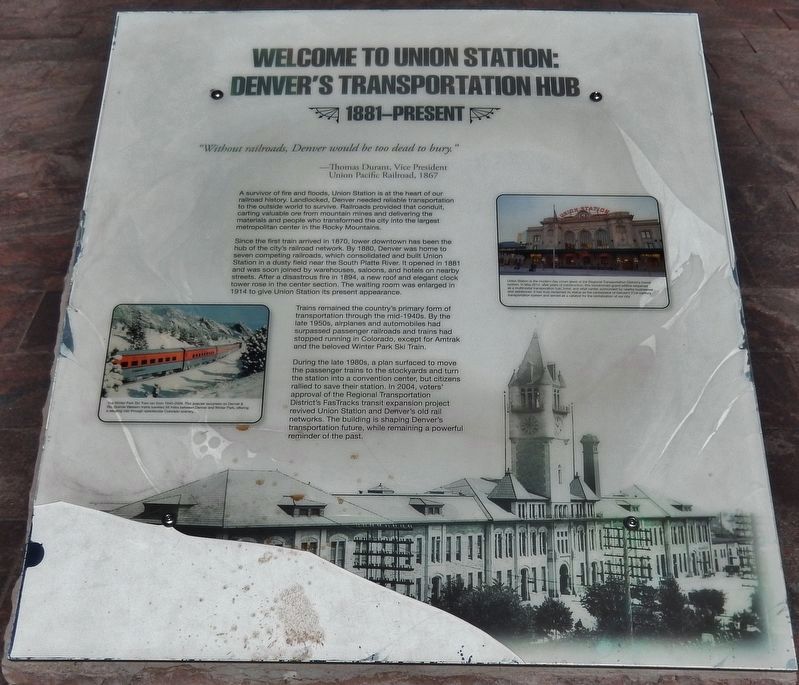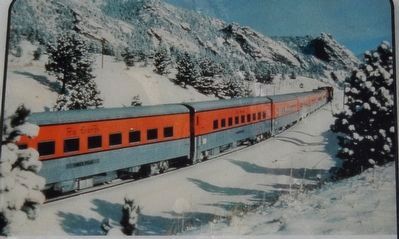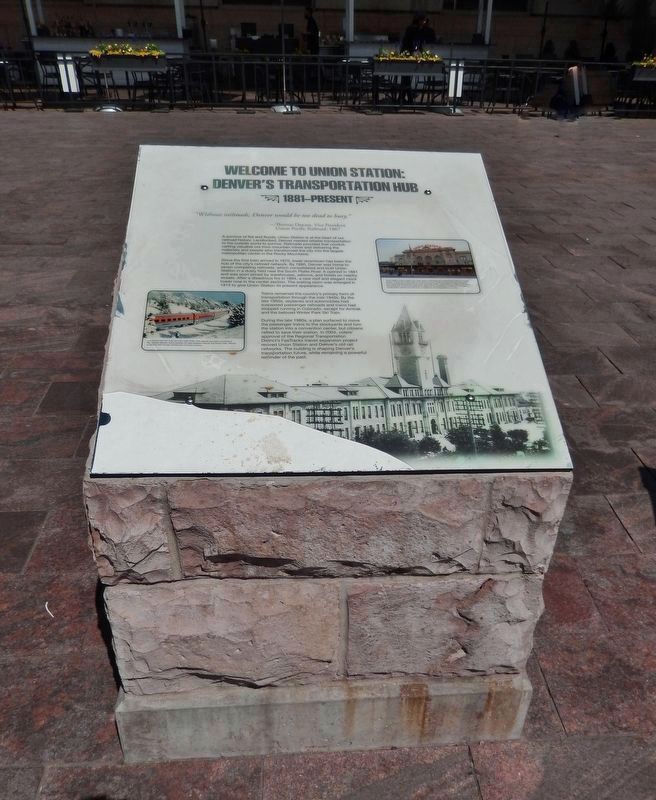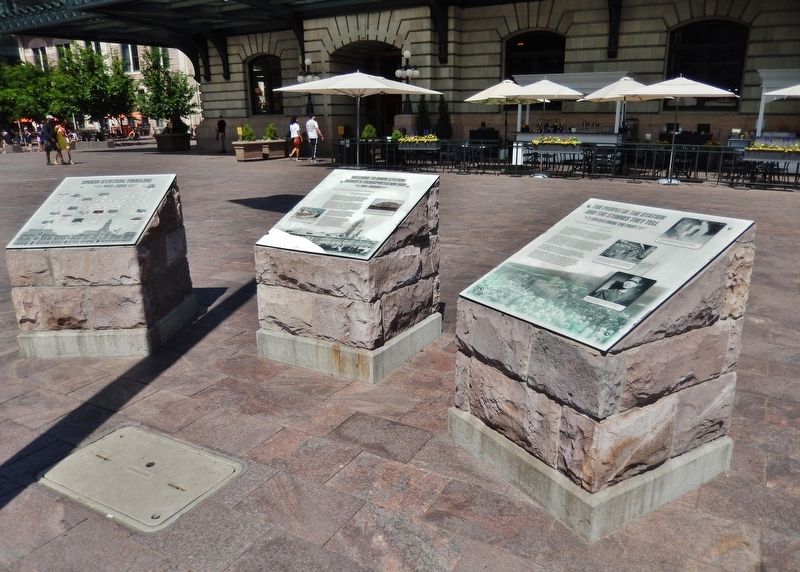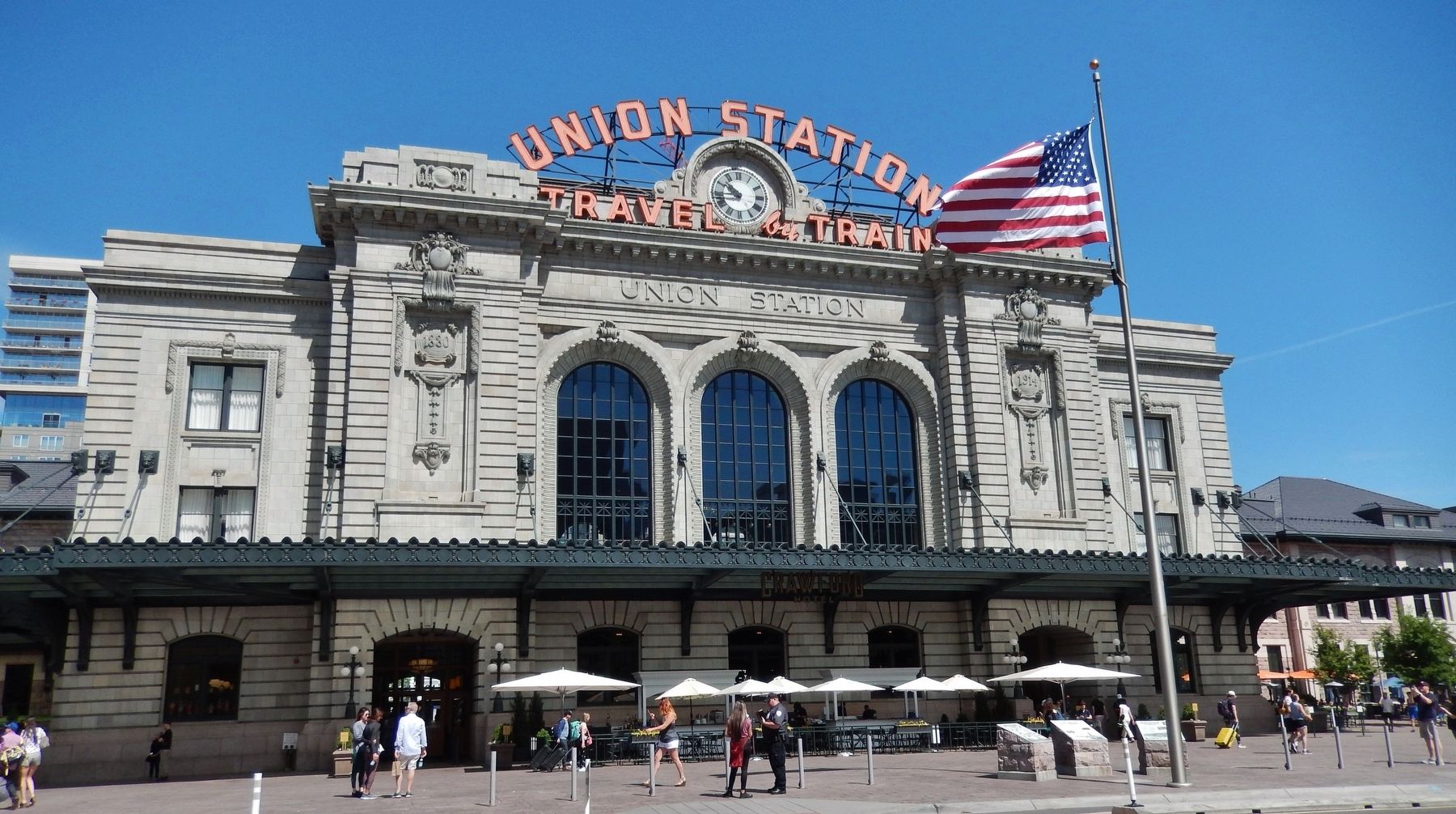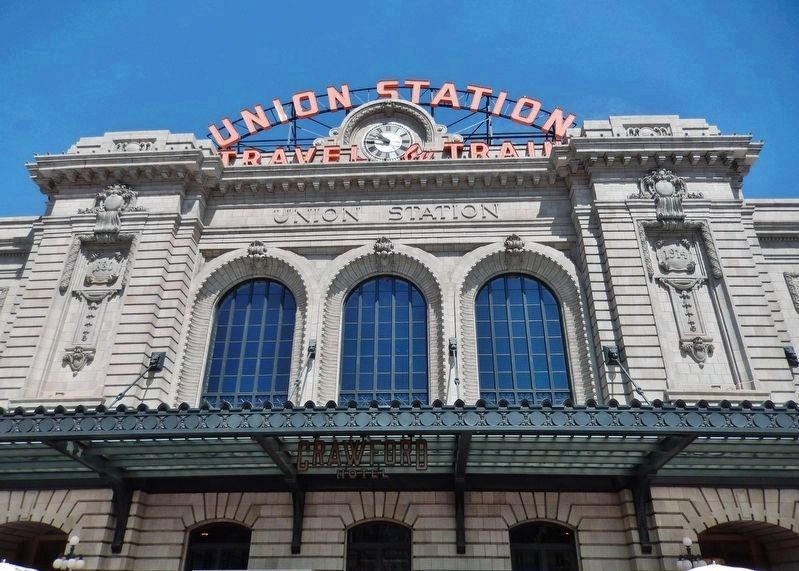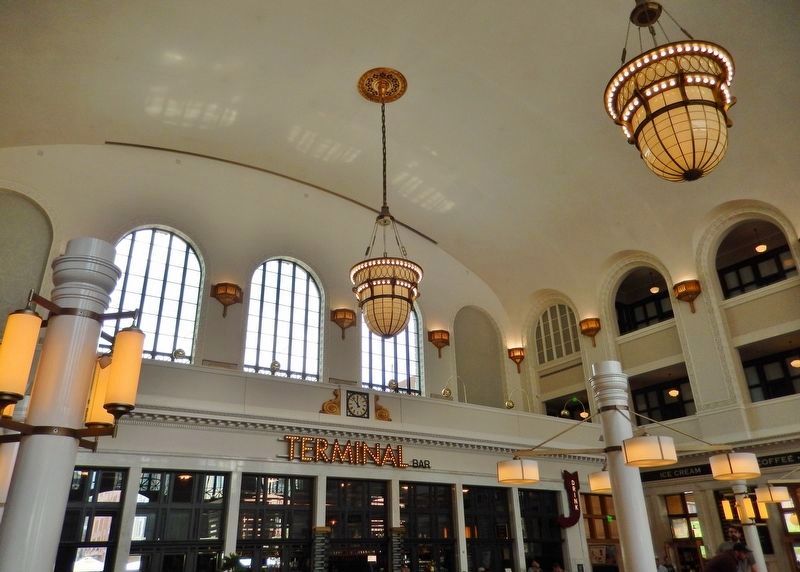Ballpark District in Denver in Denver County, Colorado — The American Mountains (Southwest)
Welcome to Union Station
Denver's Transportation Hub
— 1881 - Present —
Thomas Durant, Vice President
Union Pacific Railroad, 1867
A survivor of fire and floods, Union Station is at the head of our railroad history. Landlocked, Denver needed reliable transportation to the outside world to survive. Railroads provided that conduit, carting valuable ore from mountain mines and delivering the materials and people who transformed the city into the largest metropolitan center in the Rocky Mountains.
Since the first train arrived in 1870, lower downtown has been the hub of the city's railroad network. By 1880, Denver was home to seven competing railroads, which consolidated and built Union Station in a dusty field near the South Platte River. It opened in 1881 and was soon joined by warehouses, saloons, and hotels on nearby streets. After a disastrous fire in 1894, a new roof and elegant clock tower rose in the center section. The waiting room was enlarged in 1914 to give Union Station its present appearance.
Trains remained the country's primary form of transportation through the mid-1940s. By the late 1950s, airplanes and automobiles had surpassed passenger railroads and trains had stopped running in Colorado, except for Amtrak and the beloved Winter Park Ski Train.
During the late 1980s, a plan surfaced to move the passenger trains to the stockyards and turn the station into a convention center, but citizens rallied to save their station. In 2004, voters' approval of the Regional Transportation District's FasTracks transit expansion project revived Union Station and Denver's old rail networks. The building is shaping Denver's transportation future, while remaining a powerful reminder of the past.
Topics. This historical marker is listed in this topic list: Railroads & Streetcars.
Location. 39° 45.175′ N, 104° 59.989′ W. Marker is in Denver, Colorado, in Denver County. It is in the Ballpark District. Marker is at the intersection of Wynkoop Street and 17th Street, on the right when traveling south on Wynkoop Street. Marker is located on the plaza, near the large flagpole, directly in front of the Denver Union Station main entrance. Touch for map. Marker is at or near this postal address: 1701 Wynkoop Street, Denver CO 80202, United States of America. Touch for directions.
Other nearby markers. At least 8 other markers are within walking distance of this marker. Union Station Timeline (here, next to this marker); The People of the Station (here, next to this marker); Union Station Area (a few steps from this marker); Union Station (a few steps from this marker); Denver City Railway Building (within shouting distance
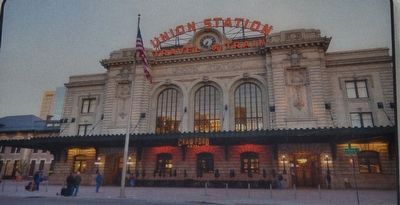
2. Marker detail: Union Station
Union Station is the modern-day crown jewel of the Regional Transportation District's transit system. In May 2014, after years of construction, this transformed grand edifice reopened as a multimodal transportation hub, hotel, and retail center, surrounded by nearby businesses and residences. It has truly reclaimed its status as the centerpiece of Denver's 21st-century transportation system and served as a catalyst for the revitalization of our city.
More about this marker. Marker is a composite plaque mounted horizontally on a large stone pedestal. Marker is the 2nd (center) of a three-part marker series located in front of Union Station.
Regarding Welcome to Union Station. Since 2014, the Union Station building also includes the Crawford Hotel, which is built into the existing structure of Union Station and captures the many eras of Denver's history.
Related markers. Click here for a list of markers that are related to this marker. Denver Union Station
Also see . . .
1. History Of Denver’s Union Station.
(This link presents several historical photos of Denver Union Station.)
Union Station reached its zenith in the 1940s, when more than 50,000 visited daily. The station served as the center of farewells and homecomings for U.S. service members during World War II. One veteran, Larry Fanning, recalls it distinctly. Still just a teenager, he left for the war from Union
Station, seen off by his girlfriend at the time and her mother.
The “Travel by Train” sign was added in the 1950s, but by that time air travel began to supplant trains. (Submitted on June 10, 2018, by Cosmos Mariner of Cape Canaveral, Florida.)
2. Union Station History.
(This link presents many historical photos of Denver Union Station.)
1894: A fire that started in the women’s restroom destroys much of the original building, including the wooden clock tower. The existing stone and brick walls of the building are kept relatively intact... allowing Union Depot to be rebuilt rather quickly with a stone clock tower, 40 feet taller than the wooden original.
1914: The stone clock tower is torn down along with the Great Hall area in order to expand the building to accommodate the growing popularity of train travel. It is rebuilt in the exterior style we see today under the new name, Union Station. (Submitted on June 10, 2018, by Cosmos Mariner of Cape Canaveral, Florida.)
3. Denver Union Station.
Denver's first train station was constructed in 1868 to serve the new Denver Pacific Railway, which connected Denver to the main transcontinental line at Cheyenne, Wyoming. By 1875, there were four different railroad stations, making passenger transfers between different railroad lines inconvenient. To remedy this issue, the Union Pacific Railroad proposed creating one central "Union Station" to combine the various operations. In February 1880, the owners of the four lines (the Union Pacific, the Denver & Rio Grande Western, the Denver, South Park & Pacific, and the Colorado Central) agreed to build a station at 17th and Wynkoop Streets. Architect A. Taylor of Kansas City was hired to develop the plans and the station opened in May 188 (Submitted on June 10, 2018, by Cosmos Mariner of Cape Canaveral, Florida.)
Credits. This page was last revised on February 7, 2023. It was originally submitted on June 10, 2018, by Cosmos Mariner of Cape Canaveral, Florida. This page has been viewed 331 times since then and 25 times this year. Photos: 1, 2, 3, 4, 5, 6. submitted on June 10, 2018, by Cosmos Mariner of Cape Canaveral, Florida. 7, 8. submitted on June 14, 2018, by Cosmos Mariner of Cape Canaveral, Florida. • Andrew Ruppenstein was the editor who published this page.
